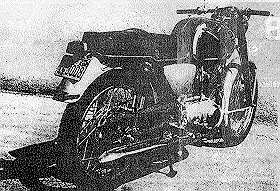Cycle World: 1963 Road Test |
||
|
||
Honda Superhawk |
||
Observations
Whatever other merits the Honda engine/transmission unit may have or lack, it is one of
the neatest looking and most oil-leak free in existence. Not once, during the entire
testing schedule, did a single drop of oil appear on the outside of the casing. In fact,
there was so little oil even from the engine breather (which is supposed to be a chain
lubricator) that the rear chain was running dry, and it was necessary to squirt some oil
at it to prevent rusting. - Ah well perhaps when our test bike gets old (it has 3500 miles
behind it at the conclusion of our testing) it will have enough blow-by to push some oil
onto the chain. Seriously, we were happy to trade the chore of an occasional look at the
chain for the oil mist that surrounds all too many engines.
 |
1963 CB77 Test Bike |
In common with most other Japanese
motorcycles, the Honda has an electric starter. It is bolted to the front of the crankcase
and turns the engine over by means of a chain drive and an over-riding clutch. The power
for the starter is provided by a 12-volt, 9-ampere/hour battery with a glass (or clear
plastic, we're not sure) case. By removing one of the tool-box/air-cleaner covers, one can
check the electrolyte level very quickly. There are two fiber filter air cleaners and
these are an enormous aid to prolonging the life of an engine.
Controls
The control layout is exceptionally well
thought out: The handlebars ate flat and low - as they should be on a racing/touring bike
- and there are three mounting positions for the footpegs. Ordinarily, the pegs would be
located in the forward mounts, but it is very little work to move them. The peg on the
right side carries the brake-lever and its actuating cable and it can be moved around
quite freely without even disturbing the brake adjustment. On the left, (the shifting
side) the foot-peg carries the shift-lever, but a longer push-pull rod would have to be
substituted before the peg could be moved. However the pegs are set, the CB77 is
comfortable, and the riding position affords a high degree of control.
Cold Starting
In getting started on chilly mornings, we were glad to have the electric starter (the emergency kick-starter had been removed from our test machine). Although the Honda has a very efficient "choking" set-up, it proved to be quite "cold-natured" and did a great deal of burbling and wheezing for the first few moments of running. At no time was this a real problem though and once, when we stupidly left the tail-light on all night and found ourselves with a flat battery, we managed a push-start after running no more than thirty feet. In short, the super-tuned Honda engine may complain a bit but it never fails to run.
| CB-77 | CYP-77 | Road Test | Riding Log | Literature | Zen | Marketplace | VJ Survey | Links | Home |